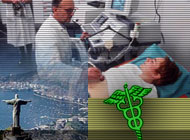Potential for healthy lives not reached in Switzerland

The Swiss federal office of public health has released figures showing that the inhabitants of Switzerland could live healthier lives, and do less damage to their natural environment at the same time.
Public health experts who presented the findings on Tuesday said Switzerland was falling behind in its goal of developing the population’s consciousness of public health and ecological matters, thereby reducing environmental and health hazards.
They were presenting the mid-term results of an action plan set up in 1997 by the health office and the Swiss environment agency. The experts called for efforts to be stepped up to change the behaviour of the Swiss.
“The need to act is great, but so is the scope for positive action”, said Charlotte Braun, a lecturer in preventive medicine at the university of Basel, charged with evaluating the action plan, which spans a period of 10 years ending in 2007.
Mobility is one area that highlights the scope for improvement. Seventy per cent of people living in Switzerland own a bicycle, and two-thirds of all journeys made every day across the country cover less than 5 kilometres. Nevertheless, only seven per cent of these journeys are actually made on bicycles.
According to the action plan, this proportion should double to 14 per cent by the year 2007.
As with mobility, where the bicycle is both environment-friendly and healthy, similar complementary advantages occur in other areas too. For instance, eating seasonal vegetables and fruit is healthy. It also encourages farmers to adopt environmentally-friendly farming methods.
The Swiss action plan was drawn up in the wake of the United Nations Earth Summit in Rio de Janeiro in 1992, at which participating nations agreed to explore such complementary advantages in each country.
The action plan includes programmes in the three areas of natural environment, mobility, and housing. Awareness programmes in each of the areas are designed to improve both the health of individuals and of the environment.
Three years after its implementation, the action plan is “still in its early stages”, as Olivier Michaud of the Swiss office of public health pointed out. However, in some of the stated aims, the action plan lags far behind schedule.
For instance, the plan aimed to ensure that by this year, non-smokers were protected from passive smoking in public places. But figures show that 51 per cent of non-smokers still suffer from passive smoking in the work place.
The action plan also wants increase the area under organic cultivation from seven per cent today to 30 per cent in the year 2007.
Health officials at the presentation on Tuesday agreed that the ambitious aims of the plan did not always correspond with the means they had to fulfil them. “We would like more support from politicians”, said Michaud.
The federal office of public health subsidises local activists and projects in the areas covered. For instance, a group of parents and teachers in Neuchatel were supported when they tried to find alternatives to driving children to school in cars.
But the health office spends only SFr250,000 on the action plan, and supports less than 20 local groups.
It is currently in the process of devising some additional pilot projects in each of the fields covered by the plan, to enhance the chances of obtaining meaningful data on which to base decisions as to the most promising measures to adopt.
by Markus Haefliger

In compliance with the JTI standards
More: SWI swissinfo.ch certified by the Journalism Trust Initiative








You can find an overview of ongoing debates with our journalists here . Please join us!
If you want to start a conversation about a topic raised in this article or want to report factual errors, email us at english@swissinfo.ch.